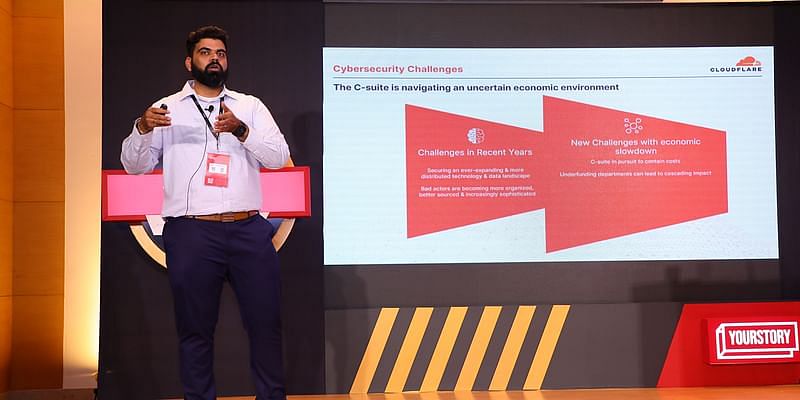Amid rising inflation and the domino effect of socio-political conflicts, financial uncertainty is unlikely to disappear soon. Amid the recession fears, organisations have to make tough decisions as they plan their IT security budgets. Cybersecurity has become one of the top spending considerations for government and private sector leaders, according to GitLab’s 2022 Global DevSecOps Survey.
“Most people agree about the role that cloud and mobile technologies play in digital transformation, but when you add the word ‘secure,’ there is little consensus about how to do it,” said Sasishar Vellamcheti, Principal Solutions Engineer, Cloudflare, at a Masterclass during YourStory’s Mumbai edition of TechSparks 2023.
Secure digital transformation is a necessary disruption — one that fundamentally changes how organisations deliver value to their customers. More specifically, it’s viewed as using modern digital technologies and processes to empower organisations to operate more efficiently, intelligently, and rapidly.
The digital revolution means businesses, organisations, and governments rely on computerised systems to manage day-to-day activities. This has made cybersecurity a primary goal to safeguard data from online attacks or unauthorised access.
Vellamcheti spoke about how digital transformation fuels an organisation’s growth. “You’re going to get significant revenues because of digital transformation. And with digital transformation, it is crucial to secure your infrastructure and your environments.
A Garner report states that most of the security spend in the last two years has been on application security, cloud security, and data security.
“Post-pandemic, users have gone hybrid. Our lives have changed. People are adopting cloud, public cloud, and private cloud, which means infrastructure is hybrid. Slowly, the applications will also go hybrid. So today, you have applications, which are probably monolithic,” he said.
Securing ever-expanding infrastructure is a major challenge as users change work patterns and applications and infrastructure evolve. “Now, we have to secure a wider infrastructure and wider footprint. That’s one major challenge security organisations are facing.”
Vellamcheti said the second challenge is that threat actors are becoming more organised and structured. “There’s state-sponsored funding that goes into the cybersecurity centre or institutionalisation of the bad actors wherein they’re becoming more organised, they are getting better funding. Because they also need monetisation,” he said.
Security vendors that have built their offerings on the use of firewalls have had to adapt to the modern landscape where hardware anchored in the data centre and security tied to a trusted network have little relevance.
Trends in cybersecurity
Continuous change in technologies also implies a parallel shift in cybersecurity trends as news of data breaches, ransomware, and hacks becomes the norm.
Vellamcheti shared how the level of sophistication when it comes to hackers is on the rise because of their usage of AI and ML.
“You [may have heard] about malware as a service. Cybercrime as a service, ransomware as a service, which was never the case before. This means that today, a guy who’s not a cybersecurity expert can reach out to people and initiate attacks. And where are the attack vectors? They’re actually focusing now on mobile apps as all of us have a lot of mobiles. There are a lot of native apps. That has become the threat vector,” he said.




![Read more about the article [Funding alert] Stockwits raises $30M, to launch in India by Q2 2022](https://blog.digitalsevaa.com/wp-content/uploads/2021/12/stock-trading-1594883703236-300x150.png)





![Read more about the article [Funding alert] Khatabook raises $100M Series C funding round, announces ESOP buyback worth $10M](https://blog.digitalsevaa.com/wp-content/uploads/2021/08/khatabookteampicture21569840696854jpg-300x150.jpeg)
